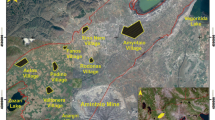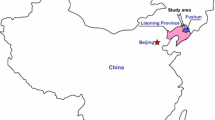Abstract
Mine collapse is a common geological hazard associated with mining areas. This study analyzes mine collapse above the Yongcheng mining area located on the Huanghuai Plain in eastern Henan Province, China. The aim is to predict surface subsidence and evaluate associated disaster risks in goaf with thick alluvial cover. The surface deformation above seven mined coalfields and six unmined coalfields was calculated using the probability integration method. The results showed that the final maximum ground subsidence would be 7.25 m for the Suburban mine and 5.3 m for the Xinzhuang mine. As part of a broader study, land subsidence was also measured over a 1-year period in 2012–2013 by interferometric point target analysis using Radarsat-2 satellite synthetic aperture radar. Interferometric displacement maps were validated with leveling data. Based on the principles of fuzzy mathematics and the analytical hierarchy process, a susceptibility assessment system was developed to define the risk from mine collapse for the coalfields across the mining area. A hazard-zoning map was also produced using the spatial analysis function of ArcGIS. These research results can serve as a reference for farmland reclamation, town planning, and the restoration of the natural environment in this area.














Similar content being viewed by others
References
Alejano LR, Ramirez-Oyanguren P, Taboada J (1999) FDM predictive methodology for subsidence due to flat and inclined coal seam mining. Int J Rock Mech Min 36:475–491
Altun AO, Yilmaz I, Yildirim M (2010) A short review on the surficial impacts of underground mining. Sci Res Essays 5(21):3206–3212
Ao MS, Wang CC, Xie RA et al (2015) Monitoring the land subsidence with persistent scatterer interferometry in Nansha District, Guangdong, China. Nat Hazards 75:2947–2964
Bawden GW, Sneed M, Stork SV et al (2005) Measuring human-induced land subsidence from space, U.S. Geological Survey Fact Sheet FS-069-03, Sacramento
Bell FG, Bruyn IA (1997) Subsidence problems due to abandoned pillar workings in coal seams. Bull Eng Geol Environ 57:225–237
Brady BHG, Brown ET (2011) Rock Mechanics for Underground Mining, 3rd edn. Science Press, Beijing
Cheng AB, Wang XM, Liu HQ (2011) Application of grey hierarchy analysis in the stability evaluation of underground mined-out areas (in Chinese). Metal Mine 416(2):17–21
Choi JK, Kim KD, Lee S et al (2010) Application of a fuzzy operator to susceptibility estimations of coal mine subsidence in Taebaek City, Korea. Environ Earth Sci 59:1009–1022
Dong SC, Sergey S, Yin HW et al (2015) Spatio-temporal analysis of ground subsidence due to underground coal mining in Huainan coalfield, China. Environ Earth Sci 73:5523–5534
Fan HD, Gu W, Qin Y et al (2014) A model for extracting large deformation mining subsidence using D-InSAR technique and probability integral method. Trans Nonferrous Met Soc China 24:1242–1247
Kwiesielewicz M (1998) A note on the fuzzy extension of Saaty’s priority theory. Fuzzy Set Syst 95:161–172
Lee S, Oh HJ, Kim KD (2010) Statistical spatial modeling of ground subsidence hazard near an abandoned underground coal mine. Disaster Adv. 3:11–23
Litwiniszyn J (1958) Statistical methods in the mechanics of granular bodies. Rheol Acta 2–3:146–150
Loupasakis C, Angelitsa V, Rozos D et al (2014) Mining geohazards-land subsidence caused by the dewatering of opencast coal mines: the case study of the Amyntaio coal mine, Florina, Greece. Nat Hazards 70:675–691
Maker BR (2010) Review of approaches to mapping of hazards arising from subsidence into cavities. Bull Eng Geol Environ 69:159–183
Marschalko M, Duraj M (2009) Knowledge of engineering-geological conditions as decisive factor for good-quality and functional foundation of potential structures. In: SGEM 2009: 9th Internatıonal Multidisciplinary Scientific Geoconference, Vol I. Conference Proceeding-Modern Management of Mine Producing, Geology and Environmental Protection 261–269
Marschalko M, Juris P, Tomas P (2008) Selected geo-factors of flood land, radon risk, slope deformations and undermining as significant limiting conditions in land-use planning. In: SGEM 2008: 8th International Multidisciplinary Scientific Geoconference, Vol I. Conference Proceeding-Modern Management of Mine Producing, Geology and Environmental Protection, pp 201–210
Marschalko M, Bednarik M, Yilmaz I, Bouchal T, Kubecka K (2012) Evaluation of subsidence due to underground coal mining: an example from the Czech Republic. Bull Eng Geol Environ 71(1):105–111
Masato F (2007) Application of interferometric point target analysis to Izu-Oshima Volcano, Japan. In: Envisat symposium 2007, Montreux, 23–27 April 2007. European Space Agency
Massonnet D, Rossi M, Carmona C et al (1993) The displacement field of the Landers earthquake mapped by radar interferometry. Nature 364(6433):138–142
Massonnet D, Thatcher W, Vadon H (1996) Detection of postseismic fault-zone collapse following the Landers earthquake. Nature 382:612–616
Nie L, Zhang M, Jian H (2013) Analysis of surface subsidence mechanism and regularity under the influence of seism and fault. Nat Hazards 66:773–780
Ouchi K (2013) Recent trend and advance of Synthetic Aperture Radar with selected topics. Remote Sens 5(2):716–807
Park I, Choi J, Lee MJ et al (2012) Application of an adaptive neuro-fuzzy inference system to ground subsidence hazard mapping. Comput Geosci 48:228–238
Saygin A, Mahmut A, Fusun BS et al (2014) Monitoring of coal mining subsidence in peri-urban area of Zonguldak city (NW Turkey) with persistent scatterer interferometry using ALOS-PALSAR. Environ Earth Sci 71:4081–4089
Song JJ, Han CJ, Li P et al (2012) Quantitative prediction of mining subsidence and its impact on the environment. Int J Min Sci Technol 22:69–73
Strozzi T, Re L, Valenti G et al (2005) SAR interferometric point target analysis of slope instabilities in the community of Biasca, Switzerland. In: Fringe ATSR workshop 2005, European Space Agency
Teatini P, Tosi L, Strozzi T (2012a) Comment on “Recent subsidence of the Venice Lagoon from continuous GPS and interferometric synthetic aperture radar In: Bock Y, Wdowinski S, Ferretti A, Novali F, Fumagalli A. Geochem Geophys Geosyst 13:Q07008
Teatini P, Tosi L, Strozzi T et al (2012b) Resolving land subsidence within the Venice Lagoon by persistent scatterer SAR interferometry. Phys Chem Earth 40–41:72–79
Tosi L, Teatini P, Strozzi T et al (2010) Ground surface dynamics in the northern Adriatic coastland over the last two decades. Rend Fis Acc Lincei 21(1):115–129
Tosi L, Teatini P, Bincoletto L et al (2012) Integrating geotechnical and interferometric SAR measurements for secondary compressibility characterization of coastal soils. Surv Geophys 33(5):907–926
Vanlaarhoven PJM, Pedrycz W (1983) A fuzzy extension of Saaty’s priority theory. Fuzzy Set Syst 11:229–241
Wang H, Li Z, Yang WM et al (2008) Formation mechanism of the ground collapse in mined-out area of coalmine underlying loose loess deposit (in Chinese). Geosci 22(5):877–883
Wang N, Wu K, Qin ZF (2012) Prediction model of mining subsidence with probability integration method based on thickness influence of loose layer (in Chinese). Coal Sci Technol 40(7):10–16
Wegmuller U, Walter D, Spreckels V, Werner CL (2010) Nonuniform ground motion monitoring with Terra SAR-X persistent scatterer interferometry. IEEE Trans Geosci Remote Sens 48(2):89–904
Werner CL, Wegmuller U, Strozzi T, Wiesmann A (2003) Interferometric point target analysis for deformation mapping. In: Proceedings of international geoscience remote sensing symposium 2003, Toulouse, 21–25 July 2003, vol 7, pp 4362–364
Wu G, Wei D, Zhou ZD et al (2014) A summary of study on ecological restoration technology of large coal bases construction in China (in Chinese). Acta Ecol Sin 34(11):2812–2820
Xu HF, Liu B, Fang ZG (2014) New grey prediction model and its application in forecasting land subsidence in coal mine. Nat Hazards 71:1181–1194
Yang HL, Peng JH (2015) Monitoring urban subsidence with multi-master radar interferometry based on coherent targets. J Indian Soc Remote Sens 43(3):529–538
Yang HL, Peng JH, Wang BC et al (2015) Ground deformation monitoring of Zhengzhou city from 2012 to 2013 using an improved IPTA. Nat Hazards. doi:10.1007/s11069-015-1953-x
Yilmaz I (2007) GIS based susceptibility mapping of karst depression in gypsum: a case study from Sivas basin (Turkey). Eng Geol 90(1–2):89–103
Yilmaz I, Marschalko M, Bednarik M (2011) Gypsum collapse hazards and importance of hazard mapping. Carbonates Evaporites 26(2):193–209
Zebker HA, Rosen PA, Goldstein RM et al (1994) On the derivation of coseismic displacement fields using differential radar interferometry: the landers earthquake. J Geophys Res Solid Earth (1978–2012) 99(B10):1961–9634
Zhang JX, Zhang Q, Sun Q et al (2015a) Surface subsidence control theory and application to backfill coal mining technology. Environ Earth Sci. doi:10.1007/s12665-015-4133-0
Zhang JZ, Huang HJ, Bi HB (2015b) Land subsidence in the modern Yellow River Delta based on InSAR time series analysis. Nat Hazards 75:2385–2397
Zhou DW, Wu K, Cheng GL (2015) Mechanism of mining subsidence in coal coalfield with thick alluvium soil in China. Arab J Geosci 8:1855–1867
Zhu GY, Xu ZH, Xie C et al (2014) Study on influence functions of surface residual movement and deformation above old goaf (in Chinese). Chin J Rock Mech Eng 33(10):1962–1970
Zou YF, Deng KZ, Ma WM (2003) Mining subsidence engineering (in Chinese). China University of Mining and Technology Press
Acknowledgments
This project was supported by the National Natural Science Foundation of China (Grant Numbers 41572301, 61427802 and 41330634) and the Fundamental Research Funds for the Central Universities of China (Grant Number 2-9-2015-071). The authors appreciate the financial support of these organizations.
Author information
Authors and Affiliations
Corresponding author
Rights and permissions
About this article
Cite this article
Zhang, B., Zhang, L., Yang, H. et al. Subsidence prediction and susceptibility zonation for collapse above goaf with thick alluvial cover: a case study of the Yongcheng coalfield, Henan Province, China. Bull Eng Geol Environ 75, 1117–1132 (2016). https://doi.org/10.1007/s10064-015-0834-6
Received:
Accepted:
Published:
Issue Date:
DOI: https://doi.org/10.1007/s10064-015-0834-6




